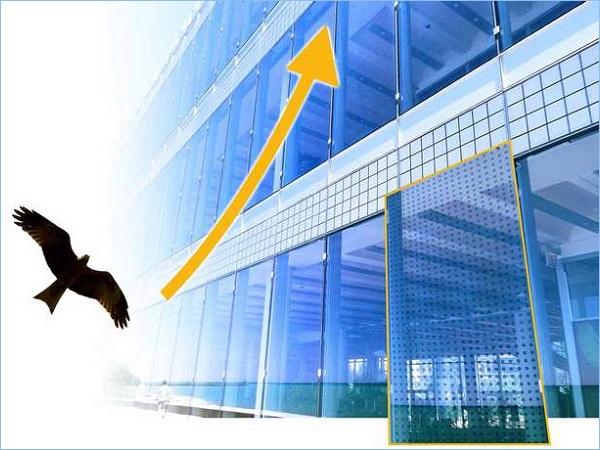
Date: 19 April 2022
Up to 100 million birds die in Europe each year because they cannot detect glass facades, bus stops, balcony glazing, greenhouses and windows as obstacles in time. Collisions with glass are the biggest unnatural cause of bird deaths – despite the fact that bird strikes can be prevented. HEGLA boraident from Halle offers laser printing as a method for preventing bird strikes, and its effectiveness has now been certified.
The easiest way to minimise the risk factor for birds would be to stop cleaning the glass. Birds are able to recognise dirty glass panes as insurmountable objects and they simply fly around them. Furthermore, dirty glass does not reflect light as effectively and birds do not perceive the mirror images of bushes, trees and the sky as being natural.

Protective function with minimal influence on the visual impression
The visually more elegant alternative to dirty glass is to rely on laser printing technology, whose two fundamental characteristics cover the range of possibilities. If aesthetics are the top priority and the bird protection finishing treatment must be subtle, tiny dots or even geometric shapes can be applied to the surface. The resulting pattern is almost imperceptible to humans. The printed pattern’s high level of transparency does not affect the overall visual impression. If a more obvious pattern is desired or the bird protection finish is to be integrated into the facade design, then logos, complex designs and symbols can be printed to be highly visible.

Wingspan as a measure for the pattern
“The key to bird protection finishes is arranging the individual elements so that a bird cannot pass through them with its wingspan,” explained Dr Thomas Rainer, authorised signatory and Head of Development at HEGLA boraident. “Black bird stickers used to be a popular, but they are not the scientific solution,” continued Dr Rainer. Birds would keep their distance from the stickers at the beginning, but would quickly try to fly past them. When producing anti-bird strike glass, this makes it even more important to add a protective texture to the entire surface in order to avoid tempting the animals to fly into it at night, when light’s power of attraction is at its highest, for example.

Effectiveness proven in the U.S.A.
The effectiveness of the HEGLA boraident laser method was scientifically proven in the U.S.A. at the beginning of the year. The American Bird Conservancy conducted trials with glass that had been laser-textured for bird protection. Hand in hand with its certification by the association, the panes finished with laser printing are now approved for the American market. In the U.S.A., Canada and Finland, there are regulatory stipulations that require such tests. Germany is in the initial stage of considering the enforcement of bird protection glass for buildings in future, based on the Nature Conservation Act. “Until a few years ago, panes like these were still a niche market,” commented Dr Rainer. “As glass facades have become bigger and the awareness of nature conservation has grown, demand from government buildings and publicly available construction projects has significantly increased.”

Permanent protection with pristine glass surfaces
The surface of the pane is not impacted by the laser printing method. The elements, dots or designs are applied by a laser in conjunction with nanoparticle tape. It is not necessary to post-process or heat the glass. The generated print cannot be felt and is wafer-thin, colourfast, lightproof, smudge-proof, and scratch-resistant.
Its protective properties include the print’s slight reflection, whose broad diffusion of light makes obstacles perceptible. The printing ink used is very subtle for humans, but to birds’ eyes, it points out an obstacle. The finishing treatment is implemented on the outside to negatively impact the mirroring of trees and plants in such a way that birds do not attempt to fly through them.
The laser print can be made with the Laserbird, Laserbird smart and even on a horizontal processing table. The processing point can be freely selected before or after cutting, and even after an ISO unit is finished.
 600450
600450




























Add new comment